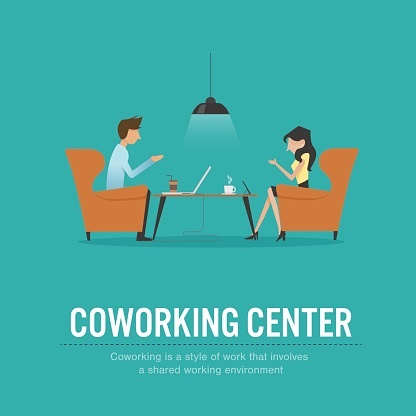6 Things Executives Should Know About Coworking and Facility Management


Step aside, coffeehouse. Coworking spaces are giving professional nomads a new place to call headquarters. These membership-based office spaces are fully equipped with modern amenities and shared by telecommuters, contractors and freelancers alike. Where home offices may stifle creativity, and coffee shops hinder productivity, coworking spaces provide a unique and social yet professional and functional environment for conducting business.
 According to an infographic created by Wix and Officevibe, an estimated 40 percent of the workforce will be freelancers, temps, contractors and solopreneurs by 2020. Global Workplace Analytics reported this year that work-from-home employment (among those who are not self-employed) has increased by 103 percent since 2005, and continues to climb. About 3.7 million professionals work from home at least part-time, if not full-time.
According to an infographic created by Wix and Officevibe, an estimated 40 percent of the workforce will be freelancers, temps, contractors and solopreneurs by 2020. Global Workplace Analytics reported this year that work-from-home employment (among those who are not self-employed) has increased by 103 percent since 2005, and continues to climb. About 3.7 million professionals work from home at least part-time, if not full-time.
This shift in the way people work inspired an explosion of coworking facilities across the country, and executives are finding creative ways to use them. In addition to freelancers, contractors and solopreneurs flocking to use these spaces, corporations are setting up coworking facilities on their own campuses to bring employees together in a creative, collaborative environment. Recruiters join coworking spaces to vet new talent. And according to Bisnow, people who work in coworking spaces are 75 percent more productive than those who work in traditional offices—which has inspired some companies to encourage their staff to get out of the main office and into these workspaces.
Here are six things executives looking to make their mark in the coworking and facility management world should know about starting and managing a coworking space.
1. You Can’t Please Everyone
People are very specific about what they want in a work environment, and as much as you’d like to appeal to everyone, it’s simply not possible. Consider the type of professionals you’d like your coworking space to attract. Are they more on the creative side of the spectrum or corporate? Your answer will determine everything about how you furnish, fill and manage the space.
Keep in mind, understanding your target audience doesn’t mean you should strip your coworking environment of diversity. In many cases, professionals are interested in coworking spaces because of the opportunity to socialize and network with different people. Diversity will help to create a rich office culture.
2. Community is Key
One of the major differences between a coworking space and a traditional office is a strong community vibe—and this isn’t something that always occurs naturally. People who are interested in coworking spaces are seeking a degree of socialization they can’t get working independently. They may find working around other professionals motivating, or even inspiring, and they see coworking spaces as an opportunity to network and share ideas with other like-minded professionals. If intermingling isn’t happening on its own, management should step in to help foster the feeling of inclusivity.
It may help to implement an application and interview process instead of an open-door policy to ensure each professional resident is a good fit for the culture. You may also want to consider using several tactics to inspire socialization:
- Distribute a regular email newsletter and feature tenants
- Hang a photo board (or start an online forum) for tenants to post pictures, articles, ads, etc.
- Provide educational opportunities, such as seminars or lunch-and-learns
- Invite tenants to after-work events, such as happy hours
- Engage with tenants via social media
3. There’s a Science to Spatial Arrangement
 Your tenants will expect certain amenities, such as comfortable chairs and workstations, wireless Internet, printer/copier access, kitchen facilities—and of course, coffee (the official fuel of business). But what about the actual setup of the workspace?
Your tenants will expect certain amenities, such as comfortable chairs and workstations, wireless Internet, printer/copier access, kitchen facilities—and of course, coffee (the official fuel of business). But what about the actual setup of the workspace?
Tenants prefer workspace variation. As mentioned above, they specifically seek coworking spaces for the social aspect, and workstation arrangements should take this into consideration. You’ll want to design the layout of your coworking space to create traffic instances that inspire impromptu conversations throughout the day—such as an open office.
It’s also important to provide areas that offer partial privacy when tenants need to keep their nose to the grindstone, and total privacy for personal phone calls or to host client meetings. Some workspaces have private phone booths or small rooms in which to make personal calls. Conference rooms that are closed off from the main working area are also preferable.
4. Tenants Want Technology
Contrary to what many executives believe, providing collaborative tools like HD-quality video conferencing, whiteboarding stations, projectors and multimedia equipment may not be considered a selling point. True, these items are a major perk compared with the limitations of a home office, but they’re also becoming an integral part of business communication today. And as such, they are expected of a modern workspace. This is especially true if your target tenants fit into the Millennial generation, or the up-and-coming Generation Z.
5. Unique Features Sell
Consider inimitable qualities that will add value to membership rates and help your facility stand out. This could be its location, or a complimentary concierge service that refills coffee, stocks the snack bar and handles lunch orders.
For example, Link Coworking in Austin, Texas, gives tenants both an indoor and outdoor working space. Hera Hub in San Diego is a women-only workspace with spa-like features that have attracted more than 100 women-owned businesses. And Flip-Work in Los Angeles provides tenants with a “Decompression Room” complete with a pool, table games and a rooftop bar/restaurant.
6. Monitor Utilization
 More important than having all the expected tools and furnishings of a modern-day coworking space is having the ability to properly manage them. You want the space to work perfectly for professionals so you should monitor how the space is used. Is the utilization of tools and space flowing seamlessly, or are certain amenities constantly in use? Tenants should be provided with equal access to all resources, and a room scheduling system should be in place to ensure that happens.
More important than having all the expected tools and furnishings of a modern-day coworking space is having the ability to properly manage them. You want the space to work perfectly for professionals so you should monitor how the space is used. Is the utilization of tools and space flowing seamlessly, or are certain amenities constantly in use? Tenants should be provided with equal access to all resources, and a room scheduling system should be in place to ensure that happens.
It’s also important that the coworking space infrastructure is constantly monitored, as any downtime or equipment malfunctions could impact your tenant’s ability to work, and will undoubtedly result in frustration and complaints. Coworking facility managers (especially those managing multiple coworking facilities) should consider using space management software to better visualize space utilization, occupancy and capacity. Space management software also will help management forecast spatial needs based on fluctuating population.
The future of workspaces is here, and inarguably here to stay. By thoughtfully planning and developing a coworking environment that aligns with your target audience, equipping the space with modern technology, and monitoring usage, executives can create and manage vibrant, highly efficient environments that inspire innovation and retain tenants long-term.
A successful coworking space relies on the right tools. Learn how your office space can benefit from space management software in our free eBook The Essential Guide to Space Management Software.
